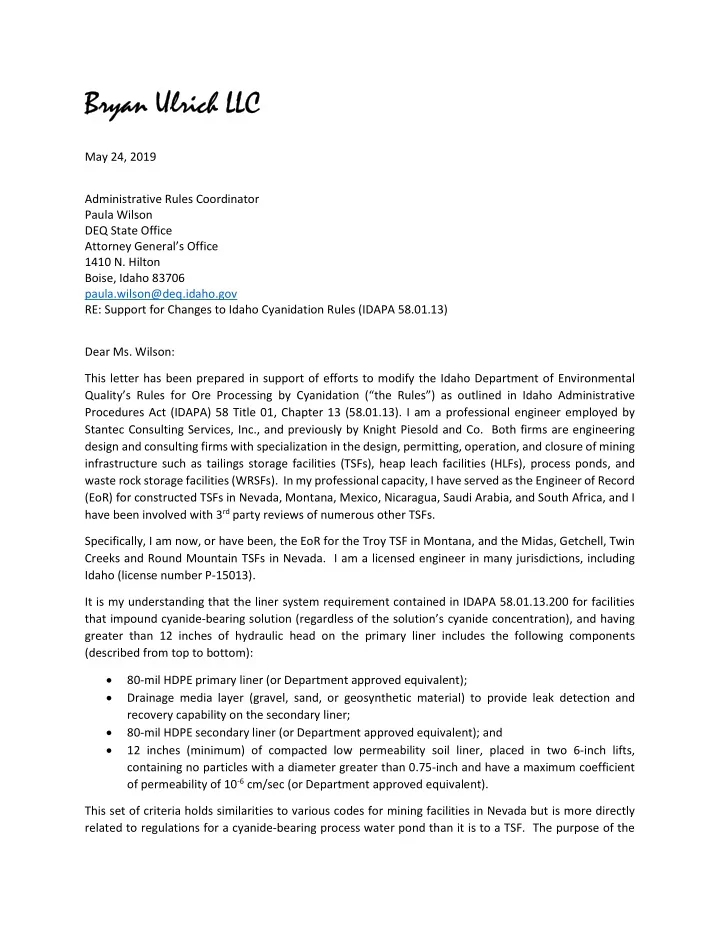

Bryan Ulrich LLC May 24, 2019 Administrative Rules Coordinator Paula Wilson DEQ State Office Attorney General’s Office 1410 N. Hilton Boise, Idaho 83706 paula.wilson@deq.idaho.gov RE: Support for Changes to Idaho Cyanidation Rules (IDAPA 58.01.13) Dear Ms. Wilson: This letter has been prepared in support of efforts to modify the Idaho Department of Environmental Quality’s Rules for Ore Processing by Cyanidation (“the Rules”) as outlined in Idaho Administrative Procedures Act (IDAPA) 58 Title 01, Chapter 13 (58.01.13). I am a professional engineer employed by Stantec Consulting Services, Inc., and previously by Knight Piesold and Co. Both firms are engineering design and consulting firms with specialization in the design, permitting, operation, and closure of mining infrastructure such as tailings storage facilities (TSFs), heap leach facilities (HLFs), process ponds, and waste rock storage facilities (WRSFs). In my professional capacity, I have served as the Engineer of Record (EoR) for constructed TSFs in Nevada, Montana, Mexico, Nicaragua, Saudi Arabia, and South Africa, and I have been involved with 3 rd party reviews of numerous other TSFs. Specifically, I am now, or have been, the EoR for the Troy TSF in Montana, and the Midas, Getchell, Twin Creeks and Round Mountain TSFs in Nevada. I am a licensed engineer in many jurisdictions, including Idaho (license number P-15013). It is my understanding that the liner system requirement contained in IDAPA 58.01.13.200 for facilities that impound cyanide-bearing solution (regardless of the solution’s cyanide concentration), and having greater than 12 inches of hydraulic head on the primary liner includes the following components (described from top to bottom): 80-mil HDPE primary liner (or Department approved equivalent); Drainage media layer (gravel, sand, or geosynthetic material) to provide leak detection and recovery capability on the secondary liner; 80-mil HDPE secondary liner (or Department approved equivalent); and 12 inches (minimum) of compacted low permeability soil liner, placed in two 6-inch lifts, containing no particles with a diameter greater than 0.75-inch and have a maximum coefficient of permeability of 10 -6 cm/sec (or Department approved equivalent). This set of criteria holds similarities to various codes for mining facilities in Nevada but is more directly related to regulations for a cyanide-bearing process water pond than it is to a TSF. The purpose of the
leak detection system in a process water pond, aside from the obvious, is to assist the owner in directing repairs to the primary liner, once a leak has been identified. In a TSF, the opportunity to complete a repair of the primary liner would be extremely rare, complex, and potentially present a dangerous work environment to the repair crew. In my opinion, the presence of this leak detection system in a TSF could be a long-term liability for closure, as any leakage could carry on uncontrolled (but collected) for many decades. The Nevada Administrative Code for water controls for tailings facilities is governed by NAC 445A.437, Minimum design criteria: Tailings impoundments, as follows: 1. A tailings impoundment must utilize a system of containment equivalent to: a) Twelve inches of recompacted native, imported, or amended soils which have an in place recompacted coefficient of permeability of no more than 1x10 -6 cm/sec; or b) Competent bedrock or other geologic formations underlying the site which has been demonstrated to provide a degree of containment equivalent to paragraph (a). 2. An alternate level of containment may be required by the Department for all of the tailings impoundment or for a portion thereof after considering the following factors: a) The anticipated characteristics of the material to be deposited; b) The characteristics of the soil and geology of the site; c) The degree to which the hydraulic head on the impoundment liner is minimized; d) The extent and methods used for recycling or detoxifying fluids; e) Pond area and volume; f) The depth from the surface to all groundwater; and g) The methods employed in depositing the impounded material. For other mining facilities, the NAC requires a minimum thickness of 12 inches of soil and be compacted in lifts which are no more than 6 inches thick. Except when used in tailing impoundments, a soil liner must have a permeability of not more than that exhibited by 12 inches of 1x10 -7 cm/sec material . Thus, Nevada provides an allowance to specifically decrease the protection levels for a soil liner in a TSF. I have personally been in responsible charge of TSF designs, construction and operation in Nevada that had compacted soil liners, but no geosynthetic liner or were partially lined with a geosynthetic liner. On the other hand, I have been the EoR for a TSF in Nevada for a facility that was designed using an 80 mil HDPE geosynthetic liner that was constructed over a liner bedding material (i.e., no clay). At another facility, the TSF basin was fully lined with an 80 mil HDPE liner overlying 12-inches of recompacted native soils which had an in place recompacted coefficient of permeability of no more than 1x10 -6 cm/sec (constructed in two 6-inch lifts). Each of these designs was developed using site-specific requirements for safe operation of the TSF, and protection of the waters of the State, while complying with all applicable water quality regulations. When engineers are provided with the opportunity to develop site-specific TSF designs through the development of a risk-informed process, fit-for-purpose facilities may be designed. Modifying Idaho’s existing Rules for Ore Processing by Cyanidation to allow designers to propose alternative, or site-specific, designs will allow for the required protection of waters of the State. Should you have any questions or comments, please do not hesitate to contact me.
Sincerely, Bryan Ulrich, PE President, Bryan Ulrich LLC 376 No. Ogden St. Denver, CO 80218
Recommend
More recommend